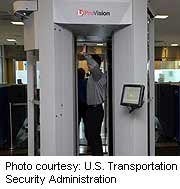
THURSDAY, March 17 (HealthDay News) — Long-term health dangers from the type of airport body scanners that emit radiation are tiny, experts say, but disagreement lingers over the collective cancer risks because of the sheer mass of travelers who pass through them every year.
In a pair of competing articles in the April issue of Radiology, radiation experts David J. Brenner and David A. Schauer debate the benefits and potential hazards posed by backscatter X-ray scanners, which are used to screen up to a billion travelers annually at airport security checkpoints in the United States.
Another type of scanner, which uses millimeter wave technology, does not emit ionizing radiation and has no proven health effects, which Brenner and Schauer agree is the ideal. But U.S. airports use a mix of both scanner types, with the only alternative being the controversial full-body pat-down.
The makers of the backscatter scanners, Rapiscan Systems, have said that the devices emit a dose of radiation equivalent to 1/1000 of a dental X-ray.
“The individual risks are obviously extremely small,” said Brenner, director of the Center for Radiological Research at Columbia University in New York City. “A good analogy … is that it’s like a lottery. You buy a ticket, and the chances of winning are minuscule — but that doesn’t mean no one will win the lottery.”
“So we won’t know who it is who gets these radiation-induced cancers,” he added, “but it’s going to be someone.”
The U.S. Transportation Security Administration started using advanced imaging technology as an extra security precaution in 2007, expanding it to a primary measure in early 2010 after the unsuccessful attempt by a passenger to blow up a plane with explosive powder.
Schauer, executive director of the National Council on Radiation Protection and Measurements, contends that adding up trivial risks over large populations or time periods produces a distorted image of risk. In many cases, he noted in his paper, the collective dose increases with the number of people exposed, but the benefits and risks to each person remain constant.
“The risk of health effects from backscatter X-ray systems … is very small as long as their use is justified, optimized and complies with applicable dose limits,” Schauer said. “When these fundamental radiation protection objectives are achieved, the benefit of exposing people to X-rays exceeds any risk.”
Radiation doses from backscatter scanners are orders of magnitude smaller than the doses sustained from the 3.6 billion medical scans done each year worldwide that use radiation for diagnostic purposes, Schauer said.
But Brenner noted that scientists have not been able to independently measure radiation doses from backscatter scanners because they have not been granted access to the machines to verify the manufacturer’s stated doses.
Peter Rez, a professor of physics at Arizona State University in Tempe, said he thinks both Brenner and Schauer make valid points in their articles.
“It’s not as if they’re at opposite ends of the spectrum,” Rez said. “The risks from a body scanner are equal to or greater than the risks of what you’re trying to prevent — terrorism — and both risks are very small.”
Brenner said he would not hesitate to go through a backscatter scanner on an occasional basis, but he would avoid the process if he were a frequent flyer or an airline employee, who might have to pass through the system several hundred times a year.
But all things considered, he said, he’d rather be screened with the no-radiation millimeter wave scanners, whose cost and effectiveness are similar.
“To me, it’s a no-brainer to use a technology with no X-rays,” Brenner said. “If you can use millimeter wave scanners … you surely should.”
More information
The U.S. Environmental Protection Agency has more on the health effects of radiation exposure.

